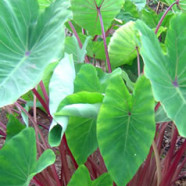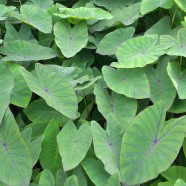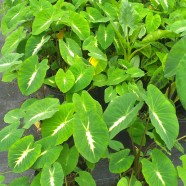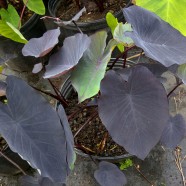Pink Stem
~ Pink Stem Taro Colocasia esculenta Aka Pink China. The hardiest colocasia yet. Intense pink stems and giant heart shaped leaves will add interest to a patio setting or lightly shaded corner of your landscape for the summer. Colocasia like very moist conditions so a pond edge would be a perfect location too. Will tolerate full sun. Keep soil wet. Fertilize frequently, heavy feeder. Height: 4-6 ft. Sun Exposure: Full Sun Partial Shade
Read MoreBlue Hawaii
~ Blue Hawaii Colocasia esculenta Has large green leaves with prominent bluish-purple veins, an undulating bluish-purple margin, matte finish. Requires consistently moist soil; do not let dry out between watering. Very high moisture needs; suitable for bogs and water gardens. Height: 3-4 ft. Sun Exposure: Full Sun Partial...
Read MoreBorneo Giant
Borneo Giant Elephant Ear Ape – Alocasia Macrorhiza The king of all Alocasia reaches 7′- 10′ tall with leaves up to 5′ wide, this is the plant that will make the biggest impact in your tropical garden. When making a site selection keep your plant in an area that has bright indirect light. Alocasia plant care, If using drip irrigation allow soil to dry slightly between waterings. Do not over water any members of the alocasia family. Fertilize this heavy feeder every three weeks during the warmer months with a one half-strength fertilizer with a balanced N-P-K ratio or...
Read MoreDiamond Head
~ Diamond Head Colocasia esculenta The big, bold, purplish black leaves of ‘Diamond Head’ have a smooth, glossy finish and are supported by semi-glossy, burgundy-colored petioles (leaf stems). This cultivar was bred by John Cho at the University of Hawaii Plant Breeding Program and also boasts increased hardiness and disease-resistance. It requires moist, organic-rich soil and will even tolerate fully saturated soils, though it does not favor stagnant soil. Height: 4-6 ft. Sun Exposure: Partial Sun
Read MoreLime Zinger
~ Lime Zinger Colocasia esculenta Lime Zinger’ is the lightbulb of the garden with its 2-foot-long, heart-shaped leaves that flutter in the slightest breeze. With a motto that seems to be “the hotter, the better,” this plant’s chartreuse foliage holds its color. Plants grow as if on steroids, reaching 3 to 5 feet tall with a 4- to 5-foot spread. ‘Lime Zinger’ performs well in full sun and partial shade and doesn’t mind slightly acidic, rich, moist soil. It seems to have no problems with pests or diseases. Height: 3-5 ft. Sun Exposure: Sun Partial...
Read MoreMojito
~ Mojito Colocasia esculenta If you’re looking to add another wild and crazy elephant ear to your garden, drink up. (pronounced “Mo-he-toe”) Named after the popular Cuban mixed drink. You must grow this plant—if only to be able to tell everyone that you have a mojito waiting for them in the garden. Its green leaves are set off by dark flecks and purple stems. The speckled patterns, splotches, and streaks vary from leaf to leaf, so no two ever look quite the same. ‘Mojito’ makes a thrilling addition to perennial beds, where its exotic form and color will add more...
Read MoreNancy’s Revenge
~ Nancy’s Revenge Colocasia esculenta The intricate and unusual ‘Nancy’s Revenge’ is an exceptionally ornamental elephant ear that was discovered in the Caribbean by aroid enthusiast, Jerry Kranz, and named after his business partner, Nancy McDaniels. It may also be sold under the name, ‘Nancyana.’ Each striking leaf is solid green when it first emerges and eventually develops a broad, creamy colored, blotch along the central midvein that radiates into the peripheral veins. Requires consistently moist soil; do not let dry out between watering. Very high moisture needs;...
Read MoreBlack Magic
~ Black Magic Colocasia esculenta Requires consistently moist soil; do not let dry out between watering. Very high moisture needs; suitable for bogs and water gardens. Solid purple-black 2′ long spectacular leaves…especially great for designers who love purples and blacks! Colocasia ‘Black Magic’ makes a giant clump to 6-8′ tall with a similar spread. Height: 6-8 ft. Sun Exposure: Sun to Partial Shade
Read MorePortadora
~ Alocasia Portadora Portadora is truly a spectacular upright elephant ear. It is a large, stunning, spectacular foliage with broad, wavy, scalloped leaves and will grow up to 10 feet tall. You can grow this plant in full sun to partial shade. This is truly an architectural specimen plant for any garden. When making a site selection keep your plant in an area that has bright indirect light. Alocasia plant care, If using drip irrigation allow soil to dry slightly between waterings. Do not over water any members of the alocasia family. Fertilize this heavy feeder every three weeks during the...
Read More





